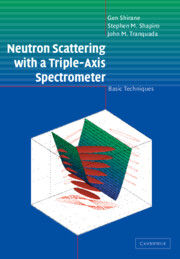Book contents
- Frontmatter
- Contents
- Preface
- 1 Introduction
- 2 Scattering formulas
- 3 Elements of a three-axis instrument
- 4 Inelastic scattering and the resolution function
- 5 Phonons and magnons
- 6 Spurious peaks
- 7 Bragg diffraction
- 8 Polarized neutrons
- Appendix 1 Neutron scattering lengths and cross sections
- Appendix 2 Crystallographic data
- Appendix 3 Other useful tables
- Appendix 4 The resolution function for a triple-axis neutron spectrometer
- Index
7 - Bragg diffraction
Published online by Cambridge University Press: 19 August 2009
- Frontmatter
- Contents
- Preface
- 1 Introduction
- 2 Scattering formulas
- 3 Elements of a three-axis instrument
- 4 Inelastic scattering and the resolution function
- 5 Phonons and magnons
- 6 Spurious peaks
- 7 Bragg diffraction
- 8 Polarized neutrons
- Appendix 1 Neutron scattering lengths and cross sections
- Appendix 2 Crystallographic data
- Appendix 3 Other useful tables
- Appendix 4 The resolution function for a triple-axis neutron spectrometer
- Index
Summary
Although Brockhouse (1961) originally invented the triple-axis spectrometer for the study of inelastic processes, it has also proven to be an exceptionally useful instrument for measuring elastic scattering in cases where the intensity is inherently low, such as in small single crystals and powders. The three-axis instrument has played an invaluable role in studies of magnetic and structural phase transitions where new superlattice Bragg peaks appear below some critical temperature. By using an analyzer, a better signal-to-noise ratio can be obtained than with the more traditional two-axis instrument with no analyzer. The intrinsic flexibility of a three-axis instrument allows one to vary the incoming and outgoing energy, and this is invaluable in detecting and eliminating the ever-present double scattering occurring within a crystal. The triple-axis instrument has developed into a versatile powder spectrometer because of the ability to significantly change the instrumental resolution by the choice of different analyzer reflections, neutron energies, and collimations.
Three-axis vs. two-axis instruments
Using a triple-axis instrument for measuring elastic scattering can significantly improve the signal-to-noise ratio when compared to the more conventional two-axis instrument used in single-crystal diffractometers or powder spectrometers. The analyzer selects only the scattering that is elastic (within the resolution of the instrument) and the inelastic scattering from the phonons, which occurs at finite energy transfers, is automatically excluded. In a two-axis instrument this phonon scattering always appears as background, and is commonly referred to as thermal diffuse scattering (TDS). Also, since analyzer crystals such as pyrolytic graphite have reflectivities of greater than 50%, there is little intensity lost.
- Type
- Chapter
- Information
- Neutron Scattering with a Triple-Axis SpectrometerBasic Techniques, pp. 168 - 200Publisher: Cambridge University PressPrint publication year: 2002



